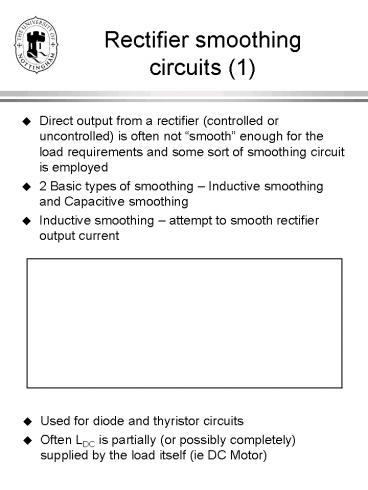Rectifier smoothing circuits 1 - PowerPoint PPT Presentation
1 / 7
Title:
Rectifier smoothing circuits 1
Description:
Rectifier smoothing circuits (1) ... 2 Basic types of smoothing Inductive smoothing and Capacitive smoothing ... Draw VXY on template and superimpose VL ... – PowerPoint PPT presentation
Number of Views:670
Avg rating:3.0/5.0
Title: Rectifier smoothing circuits 1
1
Rectifier smoothing circuits (1)
- Direct output from a rectifier (controlled or
uncontrolled) is often not smooth enough for
the load requirements and some sort of smoothing
circuit is employed - 2 Basic types of smoothing Inductive smoothing
and Capacitive smoothing - Inductive smoothing attempt to smooth rectifier
output current
- Used for diode and thyristor circuits
- Often LDC is partially (or possibly completely)
supplied by the load itself (ie DC Motor)
2
Rectifier smoothing circuits (2)
- Capacitive smoothing attempt to smooth
rectifier output voltage
- Only used with diode circuits
- Extensively used as the front end to provide
the DC link (DC supply) needed for PWM inverter
variable speed drive systems (see later in
module), often LC version (next page) is used at
higher powers
3
Rectifier smoothing circuits (3)
- A combination of Capacitive and Inductive (LC)
smoothing is sometimes used for diode circuits - Operates like inductive smoothing if rectifier
output current is continuous - Operates like capacitive smoothing if rectifier
output current is discontinuous (ie has intervals
where it 0)
- Analysis of all smoothing circuits depends on
whether rectifier output current is continuous or
discontinuous - Discontinuous capacitive (usually), Inductive
at very low output currents, L-C at low output
currents - Continuous inductive at normal output currents,
LC at high output currents
4
Inductive Smoothing- continuous current
- Waveforms see handout
- Analysis method to find ?I for a given L or vice
versa - Assume VL is smooth
- Use mean value of ID to determine VXY waveform
(ie ? and ?) - VL mean value of VXY (mean voltage across
inductor 0) - Draw VXY on template and superimpose VL
- Determine whether VL crosses VXY above or below
the overlap part of the waveform - Calculate the easier of the two areas (above or
below VL) and use ?I voltage-time area/L - If VL happens to cross through the overlap part
of VXY then neglect the smaller of the two little
triangular areas formed - If the inductor has a resistance R then use the
approximation VL Id(mean) R mean of VXY - See worked example (to be handed out)
5
Inductive Smoothing- discontinuous current
- If the mean value of Id is progressively reduced
(due to changing load for example), the ripple in
Id means that it will eventually touch 0 (before
the mean value gets to zero) and all the devices
in the rectifier will turn off - The current will stay at zero until another pair
of devices is forward biassed (diode circuit) or
another pair of devices is fired (thyristor
circuit) - This is discontinuous current operation see
handout for waveforms - Things to note
- There is no overlap
- Each thyristor must be fired twice (once at the
normal place and again 60O later) to get proper
operation if the current is discontinuous
otherwise we will never get a current path - The expression for VXY(mean) derived before no
longer holds VXY(mean) is bigger than this - VXY(mean) depends strongly on the load current
rectifier has considerable regulation in this
mode can cause control problems see H5CEDR - Can be analysed like capacitive smoothing (see
later) for the diode case more difficult for
thyristor case in general
6
Capacitive Smoothing
- See handout for waveforms
- Current normally discontinuous unless extra AC
side inductance is added and current is high we
will assume discontinuous current - For analysis assume capacitor voltage is smooth
see handout - Things to note
- There is no overlap
- Supply current has very high harmonic distortion
distortion factor is poor (displacement factor
is OK) hence power factor is poor - Power factor can be improved by adding AC side
inductance to make pulses of current broader and
lower - Poor power quality aspects of this circuit are
making it increasingly unacceptable but it is
still used in very large numbers
7
LC Smoothing
- If current is continuous analyse exactly as
inductive smoothing - If current is discontinuous analyse as
capacitive smoothing - Remember to add the DC side inductance in the
equation for calculating the peak current

